Outside/In: LA Art Fair
(The following is Part One of a Two-Part series about the Los Angeles Art fair- including intro/background from our friendly new “critic” Vincent.)
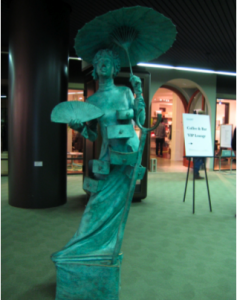
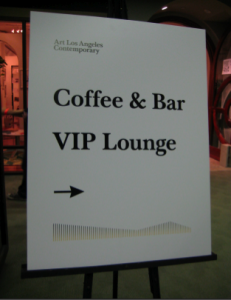
After I graduated from college I went to Russia to work with an experimental theater group called “The Theater of Generations,” in St. Petersburg. When I was not designing at the theater, I was taking drawing classes at the St. Petersburg Academy of Applied Arts, known in Soviet times as the Vera Mukhina Academy.
When I came back to Los Angeles I was completely out of touch with what was happening in contemporary art in LA. So I started checking out websites like Daily Serving and emailing artists that I liked, asking for some kind of interview, or any kind of unpaid internship; no real responses. So I wrote to a fellow alumni, Maureen Weiss who sent me to the Art Fair at the Pacific Design Center.
I was shocked by how much I had to pay. I know that its worth it, but just for a two day ticket and parking it was $44. I know to a lot of the people there, it does not sound likea lot , but for some of us, this is not an easy time to be giving large amounts of money. And to have a fair where a young artist can see the direction of where art is going, and then to exclude them with the price is just…wrong.
When you first walk in, it felt like what I imagined the salons in Paris to be like – wealthy collectors in expensive clothing asking about prices of work. You would think the art community would be somewhat open and equal, but no – there was a VIP room, and the sign was right as you walk in, ironically enough next to a statue of some rich 20th century looking Parisian.
Walking around, it was clear that I was a foreigner. There was definitely some kind of uniform in place, and it was not what I had on (dickies and t shirts). For the most part I was treated very well by the gallery owners and workers, with a few exceptions – people who did not have the time of day for a non-buyer. It all felt very overwhelming, and people were definitely trying to flex their financial and intellectual muscles.
As far as the art I saw, a lot of it was really experimental and eye-catching, but hard to relate to. And if I canʼt have any kind of relationship, how can I pull meaning from it? In an interview with Art 21, Robert Adams says, “I think art is the sworn enemy of nihilism. ” He goes on say, “Sam Johnson, a great hero from the literary world back in the 1700s, said that in life there is much to endure and little to enjoy. To the extent that thatʼs true, life is hard to accept. And I think that the reason people flock to museums now, and did so during the twentieth century, was in large measure because of their hope that art would help reconcile that very difficult truth. My fear is that we in the art world are not consistently and ardently enough addressing that old traditional job of art—to reconcile us to life.”
For the most part, I agree with this statement, and used it as a compass to guide me through the fair. I would like to make it clear that I am not an art critic and I have no training in the critique of art, but here are some things that I liked and why.
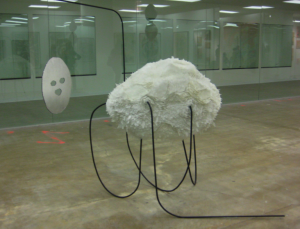
Compositionally, I feel the sculpture is a coherent whole and has a great flow, for the eye. What I like most about this, is the slippage the work evokes. It raises questions of, is this what I see, am I connecting the head to the body because of habit? From the back you really get the sense that these are two objects, but because they are in a circle with three oval cut in specific places we automatically think its a face and connect it to a the “body”. What’s great is that its unspecific enough to allow for an individual conversation with the piece. It even maintains its neurotic tone from all sides.
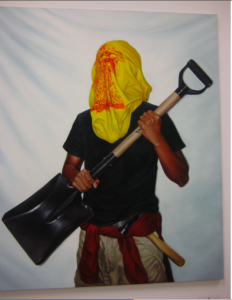
Edgar Cobain- Represented by Gallery Charro Negro
The first image is called, Trinidad. The artist adheres to kind of digital photo realism, a statement of our times. The form is compelling, and I like the symbolic connotations. For example, a masked, dark-skinned person holding a shovel and a hammer, another faceless laborer, but this one feels proud, a Rooster is his face, and the gesture of the pose feels strong. Its reflexive but it does not feel like the usual self pity we expect from expressionism.
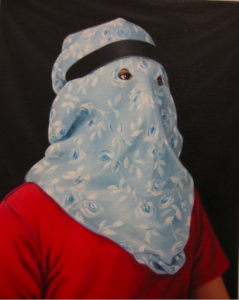
Fantasma. Here we see that by cutting holes in the fabric this painting feel much more militant in nature, some kind of Gorilla Soldier uniform, but the fabric is blue with flowers, a subversive touch.
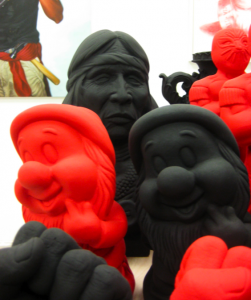
These sculptures were particularly interesting. Each one takes on a specific form, for example dwarfs, alvin the chipmunk, a native american, fists, angels, and a married couple. All of the sculptures bring forth specific memories and feelings, but when they are painted black and red they lose individuality and become bookmarks, almost like labels on a mental file cabinet of our experiences, and since each one of these objects gets the same treatment, it’s interesting to see a heroic bust of a Native American upstaged by Disneyʼs seven dwarfs.
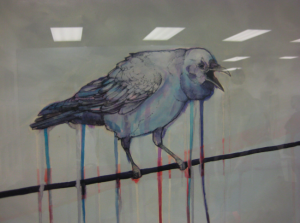
Sage Vaughn
These birds are also found in his Video “Way Down”, that you can find on youtube. “Way Down” uses the fighting of Red Cardinals and Blue Birds to symbolize the fighting between LA gangs, the Crips and Bloods. What I like about this work is that the birds are drawn and painted very well, and he uses a filmic sense of composition. The bird is painted very sharply, while the building behind it is very much out of focus. Since we are such a video based culture, the 2D composition is even more relevant because this is how we view the world through the eye of a camera. This uses the same shot composition that a camera uses. When seeing this bird alone, it does not have the same power as if you have watched the video which I highly recommend doing, it provides a great story that made me highly invested in this work.
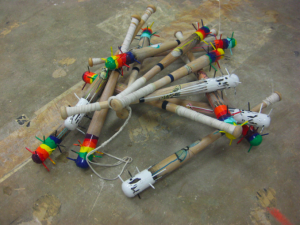
Solving History. I like how he’s taken an object from our past and puts nails in it to make it an object of violence but then subverted that by adding colors and butterflies. This makes the work violent yet playful simultaneously, two opposites smashed together, a metaphor.
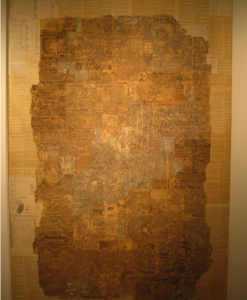
Antonis Donef- Represented by Kaltaya Gallery
Antonis Donef’s collage work is made up of torn pages out of books that are then glued back together and drawn upon with intricate detail and skill. The work from a distance seems very mad, but up close it is calm and clear. The drawings are done with pen, and it seems like there is not one smudge or mistake. Based upon our memory, and even though each little bit seems clear, when we step back it’s just little facts and pictures that are not really coherent. It’s like somebody took a person’s memory and shook it up. Just as print seems clear, with its perfect fonts, the drawings reflect the confidence and certainty of the work of the machine behind them.
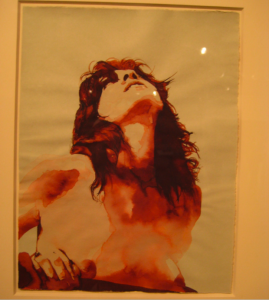
Tracy Nakayamaʼs work, this one titled “Rising”, really shows the delicate relationship that she has with her brush. I think this painting is beautiful, and because of that I feel it is transcendent and will always be relevant. Out of the whole day I feel this was one of my favorites.
(Stay tuned for part two… more art. more artists. and more insights…)
